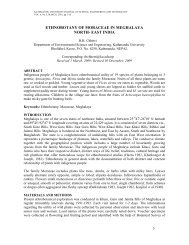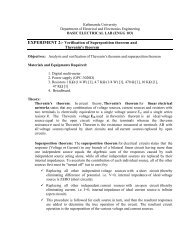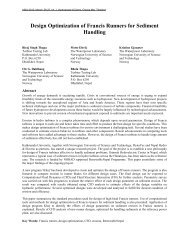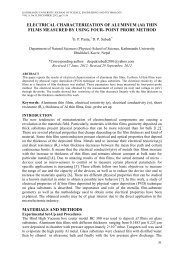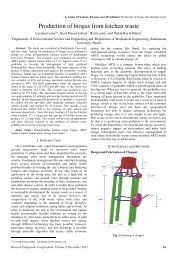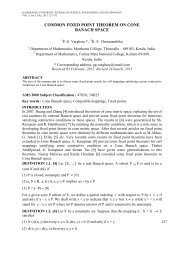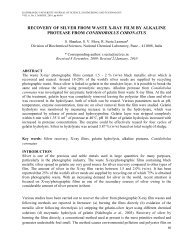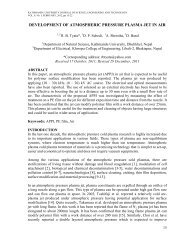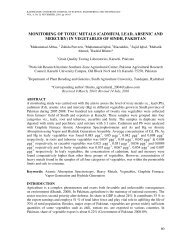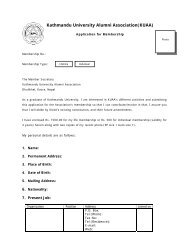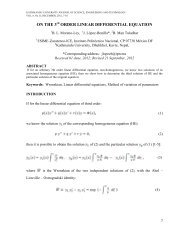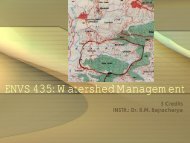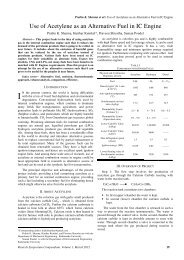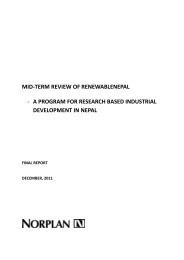ethnoveterinary practices of some plant species by ethnic
ethnoveterinary practices of some plant species by ethnic
ethnoveterinary practices of some plant species by ethnic
Create successful ePaper yourself
Turn your PDF publications into a flip-book with our unique Google optimized e-Paper software.
KATHMANDU UNIVERSITY JOURNAL OF SCIENCE, ENGINEERING AND TECHNOLOGYVOL. 8, No. I, FEBRUARY, 2012, pp 44-50RESULTS AND DISCUSSIONPresent research reveals <strong>ethnoveterinary</strong> uses <strong>of</strong> 21 <strong>plant</strong> <strong>species</strong> belonging to 19 familieswhich are widely used <strong>by</strong> the <strong>ethnic</strong> people <strong>of</strong> Parbat district. The tribes are highly dependenton the herbal remedies because diseases concepts and treatments differ in different societies,and even within a single community among gender, age, education and <strong>ethnic</strong>ity but in <strong>some</strong>cases, the medicinal <strong>plant</strong>s reported are claimed to treat the common diseases in the differentcommunities. It has been noted that leaves, stems and whole <strong>plant</strong> were the most frequentlyused <strong>plant</strong> parts for the treatment <strong>of</strong> various veterinary ailments followed <strong>by</strong> fruits, rhizomes,roots and tuber, in the order. The study has shown that foot and mouth diseases, foodpoisoning, ringworm, bone fracture, stomach disorder, injury, conjunctivitis, muscularswellings, diarrhea, reduce lactation, snakebites and lice etc. were common diseases amongthe domestic animals and few diseases reported as liver flukes, mastitis and conceivenesshave rare occurrence in the district. These findings need further clinical research to developnew herbal drugs for the effective treatment <strong>of</strong> different <strong>ethnoveterinary</strong> diseases in domesticanimals.ACKNOWLEDGEMENTSThe authors are deeply thanked and acknowledged to the tribal communities <strong>of</strong> Parbat districtfor sharing indigenous knowledge during the field work.REFERENCES1. McCorkle C M, An introduction to <strong>ethnoveterinary</strong> research and development. Journal<strong>of</strong> Ethnobiology 6 (1)(1986)129.2. Martin JG 1996, Ethnobotany: A People and <strong>plant</strong> conservation manual, Chapman andHall, 268.3. Bhattarai, N K 1992. Folk uses <strong>of</strong> <strong>plant</strong>s in veterinary medicine in Central Nepal.Fitoterapia 63 (6)(1992) 497.4. Manandhar, N P 2002. Plants and People <strong>of</strong> Nepal. Timber Press Portland, Oregon,USA: 63-487.5. Patil, S H & Merat, M M 2003. Ethnoveterinary <strong>practices</strong> in Satpudas <strong>of</strong> Nandurbardistrict <strong>of</strong> Maharasthra. Ethnobotay 15(2003) 103.6. Takhar, H K 2004, Folk herbal veterinary medicines <strong>of</strong> southern Rajasthan. IndiaJournal <strong>of</strong> Traditional Knowledge 4(2004)407.7. Bandyopadhyay, S & Mukherjee, S K, Ethnoveterinary medicine from Koch Bihardistrict, West Bengal. India Journal <strong>of</strong> Traditional Knowledge 4 (4)(2005) 456.8. Tripathi, H, Approaches in documenting <strong>ethnoveterinary</strong> <strong>practices</strong>. India Journal <strong>of</strong>Traditional Knowledge,5 (4)(2006) 579.49



